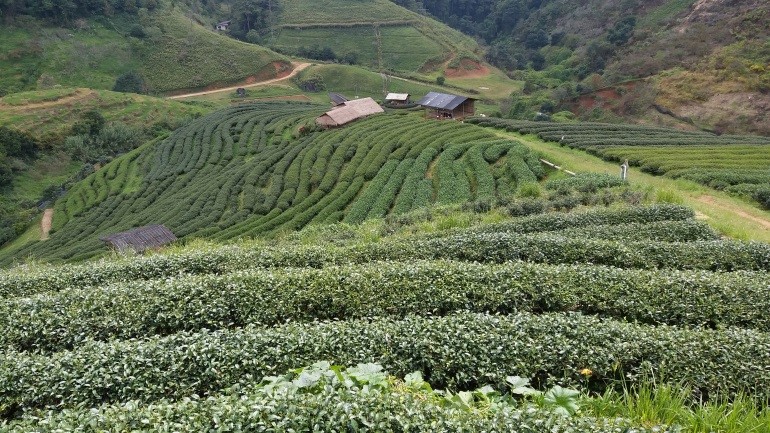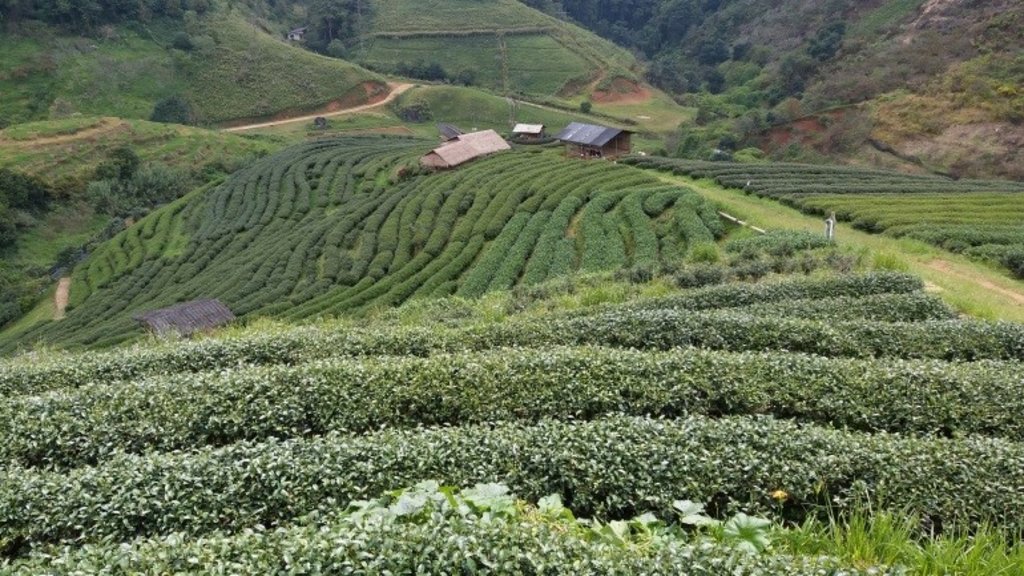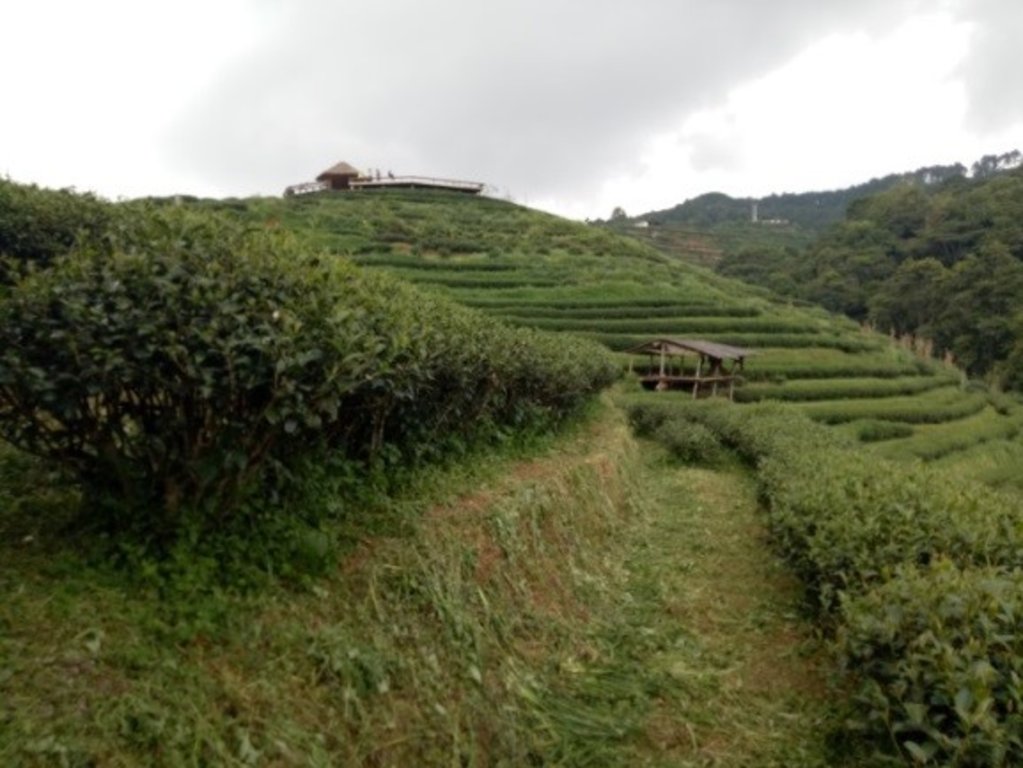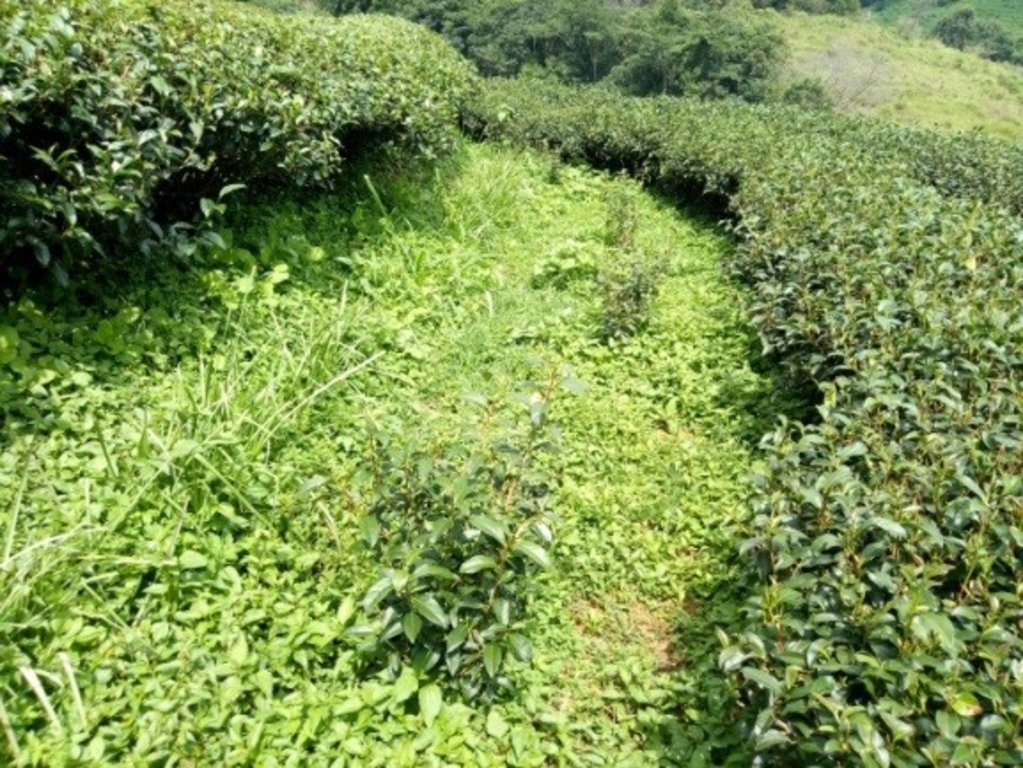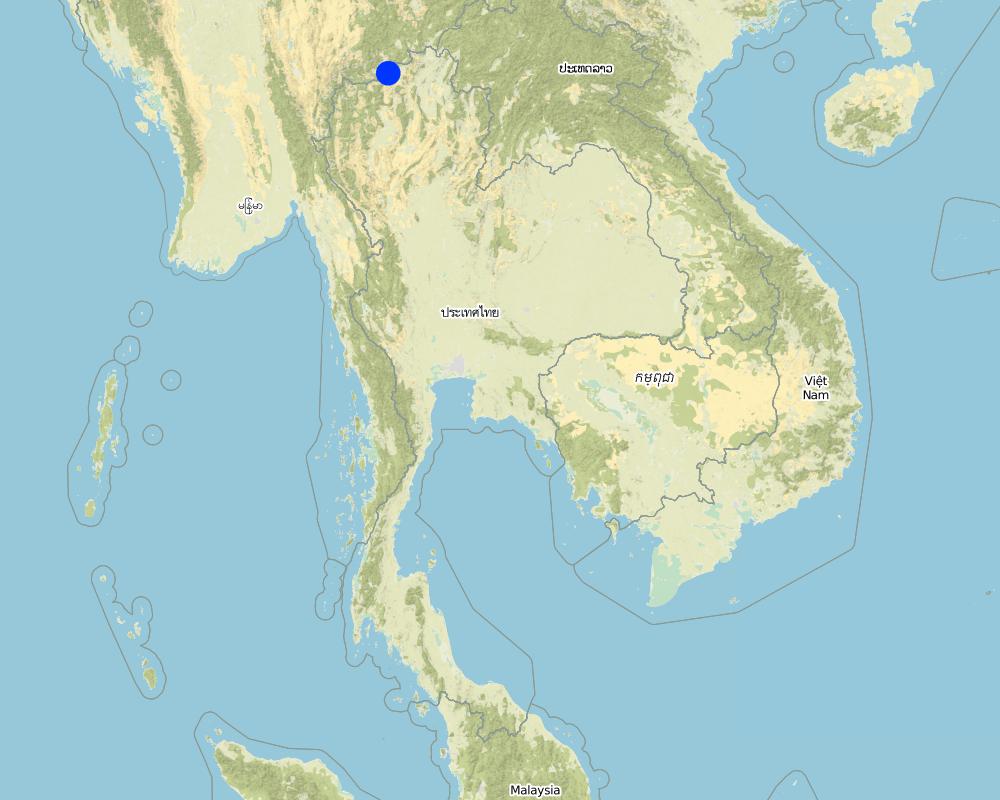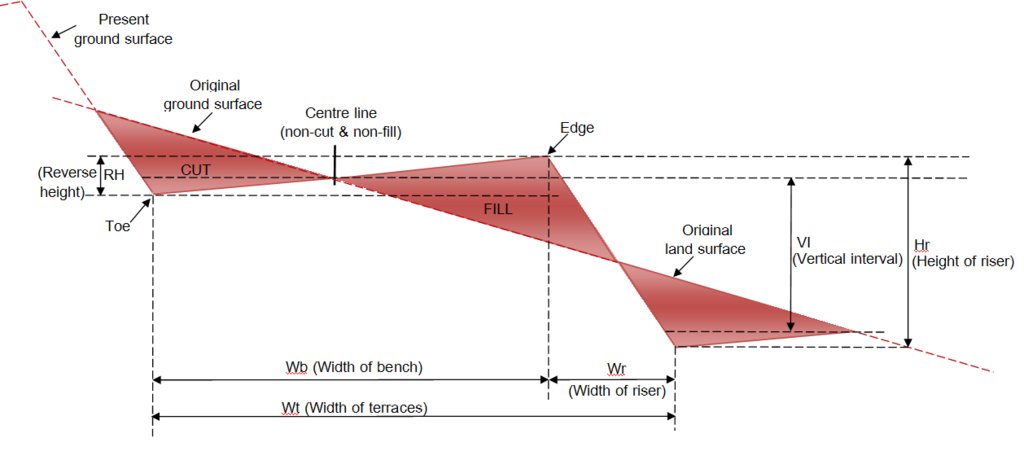Continuous bench terrace in high sloping area for tea plantation [Thaïlande]
- Création :
- Mise à jour :
- Compilateur : Pitayakon Limtong
- Rédacteur : –
- Examinateur : Rima Mekdaschi Studer
Continuous bench terrace in high sloping area for tea plantation
technologies_4281 - Thaïlande
Voir les sections
Développer tout Réduire tout1. Informations générales
1.2 Coordonnées des personnes-ressources et des institutions impliquées dans l'évaluation et la documentation de la Technologie
Personne(s)-ressource(s) clé(s)
co-compiler:
Tipvong Tanomkwan
Land Development Department
Thaïlande
exploitant des terres:
Mokngoen Jai
Palaung hill tribe farmer
Thaïlande
Local officer of Station:
Tapangtong Werapong
Angkhang Royal Agricultural Station
Thaïlande
local officer of LDD:
Boonchoo Sontaya
Royal Project Land Development Center, Land Development Department
Thaïlande
Nom du ou des institutions qui ont facilité la documentation/ l'évaluation de la Technologie (si pertinent)
Land Development Department (Land Development Department) - Thaïlande1.3 Conditions relatives à l'utilisation par WOCAT des données documentées
Le compilateur et la(les) personne(s) ressource(s) acceptent les conditions relatives à l'utilisation par WOCAT des données documentées:
Oui
1.4 Déclaration sur la durabilité de la Technologie décrite
Est-ce que la Technologie décrite ici pose problème par rapport à la dégradation des terres, de telle sorte qu'elle ne peut pas être déclarée comme étant une technologie de gestion durable des terres?
Non
Commentaires:
This continuous bench terrace with 3 meters base in slopping highland constructed at Plot 2000 for Chinese tea plantation. Such conservation measure can decrease soil erosion and runoff, and this slopping area can use for agriculture and increase land users products and income.
2. Description de la Technologie de GDT
2.1 Courte description de la Technologie
Définition de la Technologie:
Utilization of continuous bench terrace (3 meters based) as sustainable soil and water conservation measure for tea plantation in slopping area of the northern Thailand
2.2 Description détaillée de la Technologie
Description:
The continuous bench terrace (forward-sloping terrace) as soil and water conservation measure in the high landscape at Angkhang Royal Agricultural Station, Moo 5, Mae Ngon subdistrict, Fang district, Chiang Mai province was constructed in 1999 in the area of former winter fruit plantation plot of the station. Land Development Department had surveyed, designed and constructed the 3 meters wide of continuous bench terrace, which it is suitable for the tea cultivation and total area is approximately 100 rai. The Angkhang Royal Agricultural Station had selected 50 households of Palaung hill tribe who have more ability and aptitude to grow Chinese tea to participate in the Chinese tea development and promotion project in 2000 and named this area as "Plot 2000". The overview of this area is complex mountainous terrain with slope range 16-30 percent, and average attitude is 1,400 meters above sea level. The soil texture is silty loam and very deep (more tan 1.2 meter), almost well drained soil. The soil organic matter is moderate around 1-3 percent. Moreover, the data of Doi Ang Khang Meteorological Station (Station Code 48302) is located at average attitude 1,529 meters above the sea level, and average temperature throughout the year is 22.9 Celsius with the highest temperature is 32.1 Celsius (during May) and the lowest temperature is 3.9 Celsius (during December), and average annual rainfall is 1,925.3 mm, with rain starting from April to October.
In the past, the watershed areas in northern Thailand have been disturbed by natural disasters, climate change, and human threats. The hill tribe people had invaded the forest to grow opium and shifting cultivation continuously. These condition caused the serious problem in soil erosion, runoff with soil surface, lose of topsoil and plant nutrients, decreasing in soil fertility and productivity with the extremely damage to upstream forest ecosystem. Until in the year 1969, Angkhang Royal Agricultural Station was established from the initiative of His Majesty King Rama 9, which aimed to conduct research on the planting of winter economic crops as an example for hill tribe to plant those crops as their career instead of opium cultivation, and also stop cutting and shifting cultivation. Nowadays there are more than 50 species of economic plants in this project and generating more income for land users, more than that this slopping area is the sustainable in land use and land management under organization of the Royal Project Foundation.
The benefits this technology is important in sustainable utilization of land resources in this area, and all land users around the Angkhang Royal Agricultural Station have stable and more income because they can grow Chinese tea and also other winter economic crops on this highland throughout the year. Moreover, this continuous bench terrace is more convenient for land users in fertilizer application, soil improvement, machines operation, tea harvesting and also yield transportation from cultivated plots to local processing factory.
The impact of implementation continuous bench terrace with 3 meters based:
1. The obvious economic and social impacts of land users are the stability of income from the production of Chinese tea, which are produced throughout the year. This conservation is more convenient for land users to implement in their plot and also transport from cultivated plots to local processing factory. The local officers from Angkhang Royal Agricultural Station and others government agencies closely advised and guided breeding, planting, soil management, harvesting and price guarantee.
2. The environmental and ecological impact is to reduce the amount of runoff and soil sediment, increase soil moisture, preserve soil nutrients and fertility, encourage biodiversity in the area of Plot 2000.
3. The society and culture impact is all ethnic groups are given the opportunity to receive the allocation of arable land according to the group of plants that they are comfortable and want to produce. Thus respecting the use of land in zoning as allocated from the station, including right to use water. These caused the strength of community institutions, where they have various crop production groups, organic fertilizer production Group and others. They are all member of the cooperative of the community.
2.3 Photos de la Technologie
Remarques générales concernant les photos:
Soil and water conservation measure (3-meter base) as continuous bench terrace with Chinese tea cultivation on highland (at Plot 2000). The winter fruit trees in this area of AngKhang Royal Agricultural Station has been changed to the bench terrace for Chinese tea plantation with good agricultural practices (GAP) more than 19 years, which shows the appropriate land use conditions in sustainable soil and water conservation.
2.4 Vidéos de la Technologie
Date:
14/10/2018
Lieu:
Ban Thap Sub-District, Mae Chaem District, Chiang Mai Province, 50270
Nom du vidéaste:
Ms. Somjit Lertdisayawan / Ms. Tanomkwan Tipvong
2.5 Pays/ région/ lieux où la Technologie a été appliquée et qui sont couverts par cette évaluation
Pays:
Thaïlande
Région/ Etat/ Province:
Ban Thap Sub-District, Mae Chaem District, Chiang Mai Province, 50270
Autres spécifications du lieu:
Extension area for Chinese tea plantation (Plot 2000) at Angkhang Royal Agricultural Station, Mae Ngon Subdistrict, Fang District, Chiang Mai ProvincePlot
Spécifiez la diffusion de la Technologie:
- répartie uniformément sur une zone
S'il n'existe pas d'informations exactes sur la superficie, indiquez les limites approximatives de la zone couverte:
- 0,1-1 km2
Commentaires:
Angkhang Royal Agricultural Station is an area for research and development for the winter crops and trees around 1,811 rai, with high from the sea level 1,400 meters. There are hill tribe villages around the station and the total population is about 3,215 people. The weather is cool all year round with the average temperature is 17.7 degrees, the maximum temperature is 32 degrees in April. And the minimum temperature of -3 degrees in January. The average rainfall is 2,075 mm per year and slope area 20-35%.
Map
×2.6 Date de mise en œuvre de la Technologie
Indiquez l'année de mise en œuvre:
1999
Si l'année précise est inconnue, indiquez la date approximative: :
- il y a entre 10-50 ans
2.7 Introduction de la Technologie
Spécifiez comment la Technologie a été introduite: :
- par le biais de projets/ d'interventions extérieures
Commentaires (type de projet, etc.) :
The Royal Project implement in the upstream forest area and emphasize to promote and encourage career of hilltribe land users around AngKhang Agricultural Station. Moreover, the continuous bench terrace is introduced in this high slope area to prevent and conserve soil and water resources, reduce soil erosion and runoff.
3. Classification de la Technologie de GDT
3.1 Principal(aux) objectif(s) de la Technologie
- améliorer la production
- réduire, prévenir, restaurer les terres dégradées
- préserver l'écosystème
- conserver/ améliorer la biodiversité
- créer un impact économique positif
3.2 Type(s) actuel(s) d'utilisation des terres, là où la Technologie est appliquée

Terres cultivées
- Cultures pérennes (non ligneuses)
- Tea
Nombre de période de croissance par an: :
- 1
Précisez:
Chinese tea, Camellia sinensis var. sinensis in 15.43 sq.km. or 96.4375 Rai.
Commentaires:
Palaung hill tribe will plant Chinese tea on this area in late rainy season, about August to October because after planting root of tea would grow well in the cool condition and do not face problems like during the rainy season. The trimming will be about 10-12 months before planting. spacing between row is 1.2 meter and between tree is 60 centimeters. There are about 2,200 trees per Rai.
3.3 Est-ce que l’utilisation des terres a changé en raison de la mise en œuvre de la Technologie ?
Commentaires:
-
3.4 Approvisionnement en eau
Approvisionnement en eau des terres sur lesquelles est appliquée la Technologie:
- mixte: pluvial-irrigué
Commentaires:
The land use in this area is Chinese tea in Plot 2000, with 2 species, namely soft stalks and variety no.12, This area is mainly rain fed together with spraying system. And water supply system is in the upper part of the area and distribute to tea plot by PVC pipe and set springier cover over this plot. however, this water system is high cost but it is worthwhile.
3.5 Groupe de GDT auquel appartient la Technologie
- mesures en travers de la pente
- réduction des risques de catastrophe fondée sur les écosystèmes
3.6 Mesures de GDT constituant la Technologie

pratiques végétales
- V2: Herbes et plantes herbacées pérennes

structures physiques
- S1: Terrasses
Commentaires:
The continuous bench terrace technology is suitable soil and water conservation in slopping area,where is the upper part of watershed in the National Reserved Forest area. This technology need knowledge and expertise in construction of conservation measure with high investment and more maintenance. That means government and private sector should support in construction and land users should maintain of bench terrace and take care in soil fertility.
3.7 Principaux types de dégradation des terres traités par la Technologie

érosion hydrique des sols
- Wt: perte de la couche superficielle des sols (couche arable)/ érosion de surface
Commentaires:
Soil resources in this area is degraded by deforestation and climate changes, where it is risk in runoff and soil erosion. In this case plant nutrients in soil surface and sediment is removed to the low part, soil fertility is decreased, and ecosystem in upstream forest is degraded.
3.8 Prévention, réduction de la dégradation ou réhabilitation des terres dégradées
Spécifiez l'objectif de la Technologie au regard de la dégradation des terres:
- prévenir la dégradation des terres
- réduire la dégradation des terres
Commentaires:
In 1999, the Angkhang Royal Agricultural Station cooperated with Land Development Department construct the continuous bench terrace and soil improvement in this steep slope area to prevent soil erosion and runoff. Moreover, the Royal Irrigation Department support water supply system and the Provincial Electricity Authority support electricity services.
4. Spécifications techniques, activités, intrants et coûts de mise en œuvre
4.1 Dessin technique de la Technologie
Spécifications techniques (associées au dessin technique):
Operation in tea plantation in Plot 2000:
1. During 1999-2000, Angkhang Royal Agricultural Station, in collaboration with Land Development Department, conducted a survey to select the highland mountainous area with slope 20-35 percent, where land is deteriorated conditions, risk of erosion and landslides, low fertility. In order to design and construct soil and water conservation measure as continuous bench terrace with 3 meters based for Chinese tea plantations as a plot to demonstrate and promote the conservation measure on such area for Palaung hill tribe. Soil in this area is Mae Taeng soil series where it is very deep soil, with texture is sandy loam to sandy loamy, dark brown in color and soil reaction is slightly acidic (pH 5.5-6.5). In lower layer of soil profile is clay, dark red to red and soil reaction is very acidic to acidic (pH 4.5-5.5)
2. Set up the digging contour line by using wood pole from the highest point of the area to the lowest point and used the upper line is the first line of the terrace. Then dig the next contour line down along the slope and distance between the contour line is equal to distance of each terrace that is 3 meters. After that dig the terrace as 3 meters based on the contour line and set the level of terrace inclined around 1-2 degrees to drain water from this area.
3. The operation of cut and fill of soil along the contour line and move the surface soil and reshape the surface soil in this area. And dig the soil by using manpower or machine from the lower edge of the plot to make the terrace in the upper part. Therefore move, adjust and compact the soil in this area and reshape surface of soil and make terrace with 3.0 meters width and incline about 1-2 degrees, and make additional 10 percent of soil thickness to prevent the collapse, and keep the soil organic matter on the upper part of the floor and height of each terrace should not more than 1.8 meters, therefore cutting the soil down to 0.9 meters and filling the soil 0.9 meters.
4. Vetiver grass plantation conserved 2 rows of terrace by planting over the top of the terrace and planting another 1 row over the filled soil and planting spacing is 10 centimeters.
5.1 After bench terrace construction is completed in 2000, where Angkhang Royal Agricultural Station selected land users and allocated land for tea plantation for 50 households of Palaung hill tribe to set experiment of 2 varieties of Chinese tea as soft stem and breed number 12 varieties.
5.2 Land users usually planted Chinese tea at late of rainy season, which is about August to October as suitable planting season. Because after planting in this period, the root of the tea will affect the cold condition that make they grow well and do not face problems like during the rainy season
5.3 The planting period of the cutting stalk will be about 10-12 months before planting. The planting spacing is 1.2 meters in length. The spacing between stalk is 60 centimeters, and spaced about 40-45 centimeters in a row. There are approximately 2,200 trees per rai.
6. Maintenance of Plot 2000
6.1 Fertilizer application focuses on using compost from animal manure produced by this group. By digging a long groove at the end of the canopy of tea about 15 cm deep on both sides. Compost is applied 2 kilograms per tree a year, and apply 3 times during February, June, October and also use bio-extracted solution spray to tea tree for stretching the shoot with dark green leaf, plump, good weight.
6.2 Irrigation in this area use both from rain and water storage tank in the upper area and distribute directly to the plot by PVC pipe.
6.3 Almost land users in this area harvested their organic tea from April to December and will donant during January-March. At present, the no.12 variety has average yield 800 kilograms per rai, they can harvest 5-6 times a year, while the soft stem variety has average yield 600 kilograms per rai, and can harvest 4-5 times a year. In this case they would have total annual yield 60,000 kilograms and annual average income is 100,000-300,000 baht per household.
7. Maintenance of bench terrace in case of damage by runoff, all land users will repair their terrace by themselves in the dry season. In the serious case of erosion, Land Development Department will support such maintenance at rate of 500 baht per rai.
Auteur:
Ms. Tanomkwan Tipvong
4.2 Informations générales sur le calcul des intrants et des coûts
Spécifiez la manière dont les coûts et les intrants ont été calculés:
- par superficie de la Technologie
Indiquez la taille et l'unité de surface:
The area of continuous bench terrace 3 meter board
Si vous utilisez une unité de superficie locale, indiquez le facteur de conversion vers un hectare (p.ex. 1 ha = 2.47 acres): 1 ha = :
15.43
autre/ monnaie nationale (précisez):
Baht
Indiquez le taux de change des USD en devise locale, le cas échéant (p.ex. 1 USD = 79.9 réal brésilien): 1 USD = :
15448,6
Indiquez le coût salarial moyen de la main d'œuvre par jour:
175.82
4.3 Activités de mise en place/ d'établissement
| Activité | Calendrier des activités (saisonnier) | |
|---|---|---|
| 1. | Survey, select the area and design conservation measure | the first year (1998) |
| 2. | set up contour line for terrace | the first year (1998) |
| 3. | construct bench terrace | before of rainy season 1999 |
| 4. | Vetiver grass plantation on the terrace | early of rainy season 1999 |
| 5. | Chinese tea plantation | in rainy season, Aug-Oct 2000 |
| 6. | Fertilizer application 3 times | Feb, Jun and Oct |
| 7. | Water application | throughout the planting period |
| 8. | Fertilizer application | throughout the planting period |
| 9. | Harvest | harvesting period |
| 10. | Maintenance bench terrace | in dry season, April |
Commentaires:
-
4.4 Coûts et intrants nécessaires à la mise en place
| Spécifiez les intrants | Unité | Quantité | Coûts par unité | Coût total par intrant | % du coût supporté par les exploitants des terres | |
|---|---|---|---|---|---|---|
| Main d'œuvre | site survey 1 day | man | 0,5 | 175,82 | 87,91 | |
| Main d'œuvre | set up contour line 1 day | man | 4,0 | 175,82 | 703,28 | |
| Main d'œuvre | vetiver planting (400 slips x 8 rows) | slip | 3200,0 | 1,65 | 5280,0 | |
| Main d'œuvre | man power (2.4 cu.m./m.) | cu.m. | 88,0 | 100,88 | 8877,44 | |
| Equipements | machine power (2.4 cu.m./m.) | cu.m. | ||||
| Equipements | pin wood | unit | 100,0 | 5,0 | 500,0 | |
| Matériel végétal | vetiver slip (LDD supported) | None | 3200,0 | |||
| Coût total de mise en place de la Technologie | 15448,63 | |||||
| Coût total de mise en place de la Technologie en dollars américains (USD) | 1,0 | |||||
Si le coût n'est pas pris en charge à 100% par l'exploitant des terres, indiquez qui a financé le coût restant:
Land Development Department by Center of land development for Royal Project supported the budget by conduct the bench terrace in this area.
Commentaires:
-
4.5 Activités d'entretien/ récurrentes
| Activité | Calendrier/ fréquence | |
|---|---|---|
| 1. | maintain and repair bench terrace | in dry season 3-5 years/time |
Commentaires:
In the case of bench terrace are not so much damaged, and size of rill is around 5-20 cm. wide and not very deep. Most of the land users usually repair that terrace by themselves during the dry season.
4.6 Coûts et intrants nécessaires aux activités d'entretien/ récurrentes (par an)
| Spécifiez les intrants | Unité | Quantité | Coûts par unité | Coût total par intrant | % du coût supporté par les exploitants des terres | |
|---|---|---|---|---|---|---|
| Main d'œuvre | man power to repair the terrace | man | 1,0 | 500,0 | 500,0 | 100,0 |
| Coût total d'entretien de la Technologie | 500,0 | |||||
| Coût total d'entretien de la Technologie en dollars américains (USD) | 0,03 | |||||
Si le coût n'est pas pris en charge à 100% par l'exploitant des terres, indiquez qui a financé le coût restant:
All maintenance cost of bench terrace are supported by Center of Land Development for Royal Project, Land Development Department.
Commentaires:
Center of Land Development for Royal Project, Land Development Department directly cooperated with the Royal Project.
4.7 Facteurs les plus importants affectant les coûts
Décrivez les facteurs les plus importants affectant les coûts :
construction of continuous bench terrace and maintenance cost, which it is all invested by government sector, Land Development Department.
5. Environnement naturel et humain
5.1 Climat
Précipitations annuelles
- < 250 mm
- 251-500 mm
- 501-750 mm
- 751-1000 mm
- 1001-1500 mm
- 1501-2000 mm
- 2001-3000 mm
- 3001-4000 mm
- > 4000 mm
Spécifiez la pluviométrie moyenne annuelle (si connue), en mm:
1925,30
Spécifications/ commentaires sur les précipitations:
The number of rainy day is 160.9 days per year. The day with the highest daily rain (daily max.) average 149.4 mm/day in October. The number of day has storm average of 57.5 days and highest per year in May is 10.5 days
Indiquez le nom de la station météorologique de référence considérée:
Doi Angkang (Index station 48302), 19° 55' 53.0" N and 99° 2' 54.0" E, at attitude MSL 1529 m. (2006-2015)
Zone agro-climatique
- subhumide
According to data from climatic station 48302 , it is found that the duration of the precipitation period is more than half of the evaporation potential (PET) between May-October or about 6 months (180 days).
5.2 Topographie
Pentes moyennes:
- plat (0-2 %)
- faible (3-5%)
- modéré (6-10%)
- onduleux (11-15%)
- vallonné (16-30%)
- raide (31-60%)
- très raide (>60%)
Reliefs:
- plateaux/ plaines
- crêtes
- flancs/ pentes de montagne
- flancs/ pentes de colline
- piémonts/ glacis (bas de pente)
- fonds de vallée/bas-fonds
Zones altitudinales:
- 0-100 m
- 101-500 m
- 501-1000 m
- 1001-1500 m
- 1501-2000 m
- 2001-2500 m
- 2501-3000 m
- 3001-4000 m
- > 4000 m
Indiquez si la Technologie est spécifiquement appliquée dans des:
- non pertinent
Commentaires et précisions supplémentaires sur la topographie:
This technology is used in slope 20-35% , slope complex and slope more than 35%.
5.3 Sols
Profondeur moyenne du sol:
- très superficiel (0-20 cm)
- superficiel (21-50 cm)
- modérément profond (51-80 cm)
- profond (81-120 cm)
- très profond (>120 cm)
Texture du sol (de la couche arable):
- moyen (limoneux)
Texture du sol (> 20 cm sous la surface):
- fin/ lourd (argile)
Matière organique de la couche arable:
- moyen (1-3%)
Si disponible, joignez une description complète du sol ou précisez les informations disponibles, par ex., type de sol, pH/ acidité du sol, capacité d'échange cationique, azote, salinité, etc.
Angkhang Royal Agricultural Station is directly respond covered 16,577 rai, with 5 main villages, namely Ban Nala, Ban Rim, Ban Pang Ma, Ban Khum, and Ban Luang. Total population is 3,929 people. The overall landscape is slope complex in mountain range surrounded by a pan-shaped basin. This agricultural area is promoted the hill tribe community to grow winter crops. The general condition of this area is pine forest and evergreen forest. The attitude is 1,400 meters above the sea level. Most of soil series are Ban Luang Series. Soil loamy soil. Angkhang Series is a soil formed by limestone, rock, shell, shale. The overall soil condition is good structure, but almost highland with high slope and acidic condition (pH 4.5-6.0).
5.4 Disponibilité et qualité de l'eau
Profondeur estimée de l’eau dans le sol:
> 50 m
Disponibilité de l’eau de surface:
bonne
Qualité de l’eau (non traitée):
uniquement pour usage agricole (irrigation)
La salinité de l'eau est-elle un problème? :
Non
La zone est-elle inondée?
Non
Commentaires et précisions supplémentaires sur la qualité et la quantité d'eau:
In the past, there was no soil and water conservation measure, where soil erosion and severe runoff is occurred when it has heavy rain, especially during the rainy season. Soil surface was transported to the lower part, where organic matter and plant nutrients lost from this area and small rill and deep groove is formed in the upper part. Moreover such soil sediment in runoff accumulated in the channel and natural reservoir.
5.5 Biodiversité
Diversité des espèces:
- élevé
Diversité des habitats:
- moyenne
Commentaires et précisions supplémentaires sur la biodiversité:
In Plot 2000 can observe several insects in both of predators and parasitic insects such as dragonflies, beetles, turtles, striped mungs, ants, also earthworm and others.
5.6 Caractéristiques des exploitants des terres appliquant la Technologie
Sédentaire ou nomade:
- Sédentaire
Orientation du système de production:
- exploitation mixte (de subsistance/ commerciale)
Revenus hors exploitation:
- moins de 10% de tous les revenus
Niveau relatif de richesse:
- moyen
Individus ou groupes:
- groupe/ communauté
Niveau de mécanisation:
- travail manuel
Genre:
- femmes
- hommes
Age des exploitants des terres:
- jeunes
- personnes d'âge moyen
- personnes âgées
Indiquez toute autre caractéristique pertinente des exploitants des terres:
All land users and their family members worked in their land such as tea leaves harvest, weed control, fertilizer application, tea planting, trimming and others, which they would not prefer to hire workers.
5.7 Superficie moyenne des terres utilisées par les exploitants des terres appliquant la Technologie
- < 0,5 ha
- 0,5-1 ha
- 1-2 ha
- 2-5 ha
- 5-15 ha
- 15-50 ha
- 50-100 ha
- 100-500 ha
- 500-1 000 ha
- 1 000-10 000 ha
- > 10 000 ha
Cette superficie est-elle considérée comme de petite, moyenne ou grande dimension (en se référant au contexte local)?
- petite dimension
Commentaires:
The leader of Plot 2000 (Mr. Chai) has land for tea plantation 4 rai. and also Jiaogulan herb plantion 1 rai, and rental land for agriculture 1 rai.
5.8 Propriété foncière, droits d’utilisation des terres et de l'eau
Propriété foncière:
- individu, sans titre de propriété
Droits d’utilisation des terres:
- communautaire (organisé)
Droits d’utilisation de l’eau:
- communautaire (organisé)
Précisez:
-
Commentaires:
All land users in this area would not right in land ownership but they have right to use these land for agricultural purposes. And Angkhang Royal Agricultural Station separated and allocated these land for selected land users and also land zoning for fruit trees, Vegetables, flowers and ornamental plants and others.
5.9 Accès aux services et aux infrastructures
santé:
- pauvre
- modéré
- bonne
éducation:
- pauvre
- modéré
- bonne
assistance technique:
- pauvre
- modéré
- bonne
emploi (par ex. hors exploitation):
- pauvre
- modéré
- bonne
marchés:
- pauvre
- modéré
- bonne
énergie:
- pauvre
- modéré
- bonne
routes et transports:
- pauvre
- modéré
- bonne
eau potable et assainissement:
- pauvre
- modéré
- bonne
services financiers:
- pauvre
- modéré
- bonne
Commentaires:
They have cooperative activity to support investment and production costs such as fertilizers, bio-pesticides, pesticides and others.
6. Impacts et conclusions
6.1 Impacts sur site que la Technologie a montrés
Impacts socio-économiques
Production
production agricole
Commentaires/ spécifiez:
In former time land users use shifting cultivation for corn and upland rice. After organic tea farming had set up at Plot 2000 their products and income were increased and can harvest throughout the year.
risque d'échec de la production
Commentaires/ spécifiez:
They have advised from stations' staff and promote varieties, planting, production, harvest, purchase, insurance price. There are tea processing factories in the market, making tea production sustainable (integrated)
surface de production
Commentaires/ spécifiez:
this area can not extend.
gestion des terres
Commentaires/ spécifiez:
After this system has been allocated for organic tea in the Plot 2000, where soil conservation measure and soil management is need.
Disponibilité et qualité de l'eau
demande pour l'eau d'irrigation
Commentaires/ spécifiez:
This system need more water continuously.
Revenus et coûts
dépenses pour les intrants agricoles
Commentaires/ spécifiez:
This system need to maintain the terrace and more work to take care tea tree.
revenus agricoles
Commentaires/ spécifiez:
They have more income from tea product continuously.
disparités économiques
Commentaires/ spécifiez:
They have equal opportunities in earning their life.
charge de travail
Commentaires/ spécifiez:
They have more workload almost daily and continuously because they need to intensive care on terrace construction and tea tree.
Impacts socioculturels
droits d'utilisation des terres/ de l'eau
Commentaires/ spécifiez:
This system had set up zoning system for some crop by Angkhak Station, and also management in right to water utilization.
institutions communautaires
Commentaires/ spécifiez:
They have strong cooperatives and all members are the land users in this area. There are various crop production groups and organic fertilizer production group.
connaissances sur la GDT/ dégradation des terres
Commentaires/ spécifiez:
Almost land users in this area know very well about soil erosion in hillside with slopping area. and realizing that bench terrace can solve these problem and make it sustainable condition.
situation des groupes socialement et économiquement désavantagés
Commentaires/ spécifiez:
Every ethnic group has been given the opportunity to receive the allocated land according to their experience and knowledge in each crop.
Impacts écologiques
Cycle de l'eau/ ruissellement
ruissellement de surface
Commentaires/ spécifiez:
This system can reduce amount of water runoff and store some water into the soil..
Sols
humidité du sol
Commentaires/ spécifiez:
This system can store more water into the soil, and soil moisture are in soil layer longer.
couverture du sol
Commentaires/ spécifiez:
The system would have more ground cover crops.
perte en sol
Commentaires/ spécifiez:
The bench terrace is very effective in prevention of soil erosion and water storage.
accumulation de sol
Commentaires/ spécifiez:
In the upper part almost soil are accumulated in the bench terrace, that means soil fertility and nutrient still stay in the slopping area.
Biodiversité: végétale, animale
Couverture végétale
Commentaires/ spécifiez:
The system makes more crops covered soil surface throughout the year.
espèces bénéfiques
Commentaires/ spécifiez:
The system improve small animals and insects in soil such as earthworms, bees, dragonflies, spiders, ladybugs and others.
contrôle des animaux nuisibles/ maladies
Commentaires/ spécifiez:
They emphasized in organic farming, so they need to have more technical advised in natural products for pest and insect control.
Réduction des risques de catastrophe et des risques climatiques
glissements de terrains/coulées de débris
Commentaires/ spécifiez:
The system can reduce in both of amount of runoff and soil sediment to the lower part.
Précisez l'évaluation des impacts sur site (sous forme de mesures):
almost land users have been continuously advised in tea plantation and organic farming by local officers of the Station.
6.2 Impacts hors site que la Technologie a montrés
inondations en aval
Commentaires/ spécifiez:
-
envasement en aval
Commentaires/ spécifiez:
-
Précisez l'évaluation des impacts extérieurs (sous forme de mesures):
-
6.3 Exposition et sensibilité de la Technologie aux changements progressifs et aux évènements extrêmes/catastrophes liés au climat (telles que perçues par les exploitants des terres)
Extrêmes climatiques (catastrophes)
Catastrophes météorologiques
| Comment la Technologie fait-elle face à cela? | |
|---|---|
| pluie torrentielle locale | très bien |
Catastrophes hydrologiques
| Comment la Technologie fait-elle face à cela? | |
|---|---|
| glissement de terrain | bien |
Commentaires:
-
6.4 Analyse coûts-bénéfices
Quels sont les bénéfices comparativement aux coûts de mise en place (du point de vue des exploitants des terres)?
Rentabilité à court terme:
positive
Rentabilité à long terme:
très positive
Quels sont les bénéfices comparativement aux coûts d'entretien récurrents (du point de vue des exploitants des terres)?
Rentabilité à court terme:
positive
Rentabilité à long terme:
très positive
Commentaires:
Land users no need to pay any expenses. So the construction of bench terrace as 3 m. basement is set up by the Royal Project for Land Development Center.
6.5 Adoption de la Technologie
- 11-50%
Si disponible, quantifiez (nombre de ménages et/ou superficie couverte):
In Plot 2000 , They have 39 members who cultivated tea and medicinal plants in this bench terrace.
De tous ceux qui ont adopté la Technologie, combien d'entre eux l'ont fait spontanément, à savoir sans recevoir aucune incitation matérielle, ou aucune rémunération? :
- 0-10%
Commentaires:
This bench terrace need more investment and management, and need more incentives.
6.6 Adaptation
La Technologie a-t-elle été récemment modifiée pour s'adapter à l'évolution des conditions?
Non
6.7 Points forts/ avantages/ possibilités de la Technologie
| Points forts/ avantages/ possibilités du point de vue de l'exploitant des terres |
|---|
| The continuous bench terrace is high effective measure to slow down runoff, reduce sediment and soil erosion. |
| This system would reduce amount of fertilizer application, which organic matter and plant nutrients still stay in the slopping area. |
| All land users can produce more agricultural products and more income. |
| Points forts/ avantages/ possibilités du point de vue du compilateur ou d'une autre personne ressource clé |
|---|
| The continuous bench terrace is high effective measure to slow down runoff, reduce sediment and soil erosion. |
| This bench terrace increase amount of storage water into soil, and also increase soil moisture content. And the excess of rain would gradually control and drain to water way. |
| This technology would reduce amount of fertilizer application due to prevent of plant nutrients lost from this area. |
| All land users can improve their life status in increasing agricultural products and income. |
6.8 Faiblesses/ inconvénients/ risques de la Technologie et moyens de les surmonter
| Faiblesses/ inconvénients/ risques du point de vue de l’exploitant des terres | Comment peuvent-ils être surmontés? |
|---|---|
| The continuous bench terrace is very high cost | Government and local officers support this activities. |
| This system need expert in design and implement. | Local government officers (LDD) support and service this activities. |
| The structure of bench terrace is damaged. | Local government officers (LDD) support and service this activities. |
| Faiblesses/ inconvénients/ risques du point de vue du compilateur ou d'une autre personne ressource clé | Comment peuvent-ils être surmontés? |
|---|---|
| The continuous bench terrace is very high cost and need machine to construct is terrace. | Government and local officers support this activities. |
| This system need expert in design and implement. | Local government officers (LDD) support and service this activities. |
| The structure of bench terrace is damaged by heavy rain, runoff and other events. | Local government officers (LDD) support and service this activities. |
7. Références et liens
7.1 Méthodes/ sources d'information
- visites de terrain, enquêtes sur le terrain
1
- interviews/entretiens avec les exploitants des terres
1
- interviews/ entretiens avec les spécialistes/ experts de GDT
2
- compilation à partir de rapports et d'autres documents existants
-
Quand les données ont-elles été compilées (sur le terrain)?
14/10/2018
Commentaires:
More detail information is available at the Royal Project.
7.2 Références des publications disponibles
Titre, auteur, année, ISBN:
-
Disponible à partir d'où? Coût?
-
7.3 Liens vers les informations pertinentes en ligne
Titre/ description:
Continuous bench terrace for soil and water conservation in watershed area (at slope 35-60%)
URL:
http://www.dnp.go.th/watershed/ส่วนอำนวยการ/จัดทำระบบอนุรักษ์ดินและน้ำ โครงการทำขั้นบันไดดิน.pdf
7.4 Observations d'ordre général
-
Liens et modules
Développer tout Réduire toutLiens
Aucun lien
Modules
Aucun module trouvé


